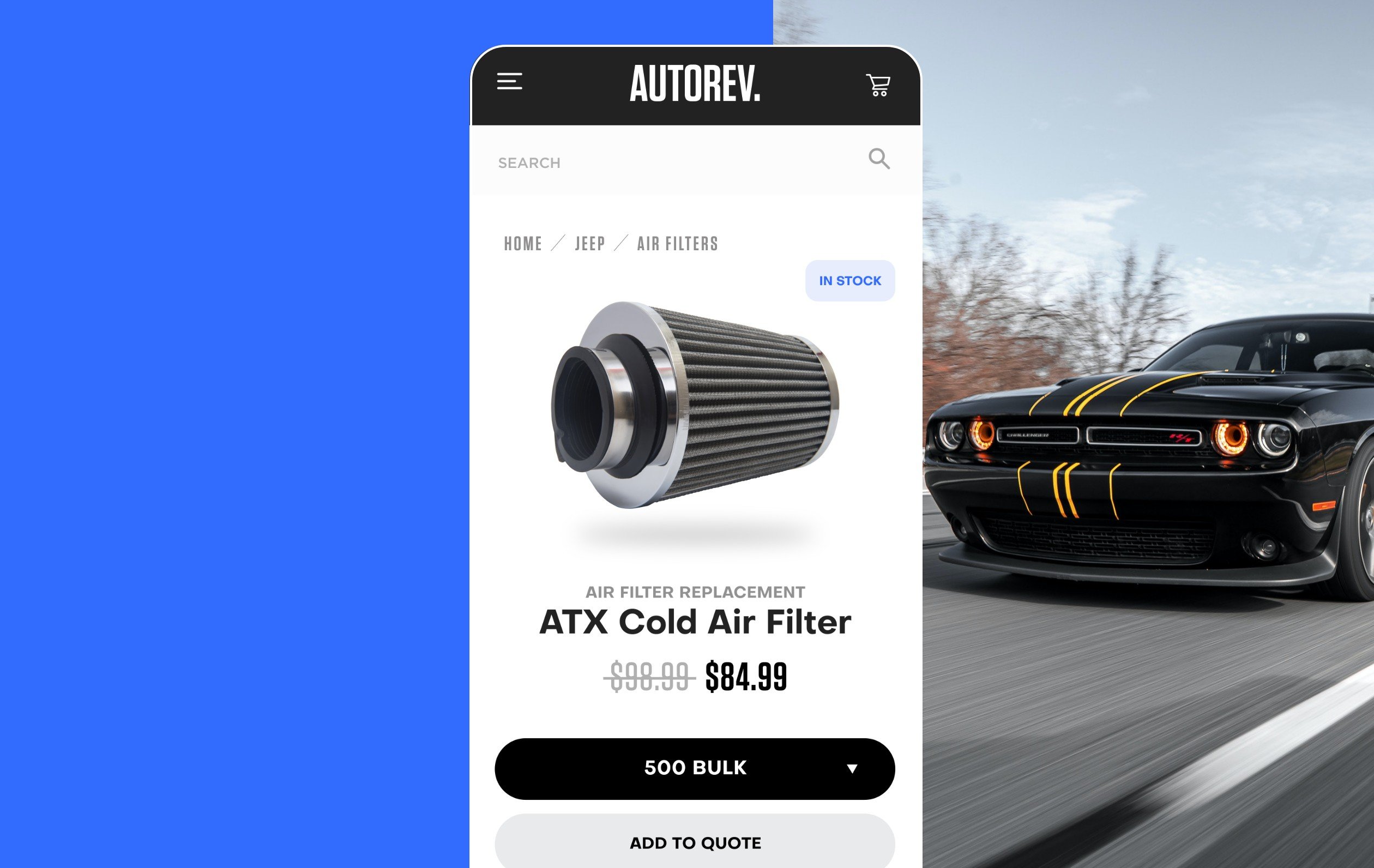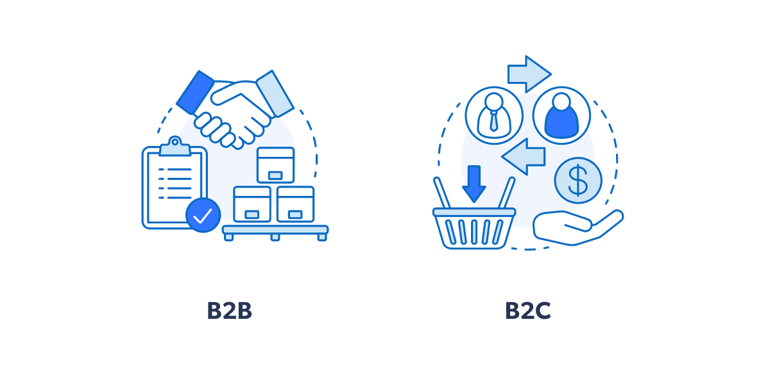
See why top ecommerce brands use Miva’s no-code platform to run
multiple stores, manage massive catalogs, and grow their revenue.
What is B2B selling? B2B sales can be highly profitable but also highly complex—and the B2B sales landscape has shifted considerably within the past decade alone. B2B selling models are increasingly digital, while many of today’s B2B buyers are more independent, preferring to conduct their own research and make their decisions with minimal input from sales representatives. With a solid understanding of the concepts and strategies behind successful online B2B sales, you can attract new business and close deals that lead to lasting relationships.
B2B (business-to-business) sales describe the process of companies selling products or services to other businesses, rather than to individual consumers. B2B sales services include supply, wholesale, services, and software. B2B sales can be more complex than B2C or DTC sales, often involving multiple people across various roles and frequently taking place over the course of several days, weeks, or months.
When selling B2B, it’s important to keep in mind that many B2B buyers are primarily concerned with logic, expertise, and ROI. This means that B2B sales processes often focus on forming and solidifying long-term client relationships built on trust and expertise.
The 4 most common types of B2B sales services include:
B2B supply companies provide materials that support the daily operations of other businesses. These may include office supplies, employee uniforms, specialized equipment, and basic items such as lightbulbs or toilet paper. Although some of these B2B supplier products are also sold in B2C or DTC models, B2B supply sales typically involve higher quantities per purchase than B2C supply sales, since businesses often require larger quantities of product. For example, while a B2C customer might purchase a single ream of printer paper at an office supply store, a B2B buyer might purchase multiple cartons that each contain 10 reams of printer paper.
B2B wholesale companies buy items or materials in bulk and at a low cost from a manufacturer. They then sell those items to other businesses that in turn sell them to customers at a marked-up price. For instance, a wholesale food company might sell produce and other basic ingredients to grocery stores and restaurants.
B2B sales encompass both product and service-based industries. Examples of B2B services include industrial cleaning companies that service office buildings, companies that run safety and compliance trainings, and outsourced corporate services like human resources, accounting, or marketing.
As the name suggests, software-as-a-service (SaaS) models are product-service hybrids, in which companies provide buyers with software that helps to run some aspect of their business as well as the technical support to keep that software running smoothly. Examples of B2B SaaS companies include accounting software like Quickbooks, communication software like Slack, and ecommerce software like Miva.

Besides encompassing the above unique industries, B2B sales differ from B2C and DTC sales in several important ways. Most of these differences stem from the unique nature of selling to a business rather than an individual consumer.
Although a B2B sales representative may have one person from a prospective client company as their main point of contact, that person is acting based on the interests of their company, rather than solely on their interests as an individual. Likewise, there will often be multiple employees and stakeholders involved in the decision-making process. So, just as B2B marketing requires different angles and strategies than B2C and DTC marketing, B2B sales requires different tactics than B2C and DTC sales.
The B2B buyer journey looks different from the consumer purchasing journey. While consumers make their buying decisions based on their own personal needs or the needs of other individuals, B2B buyers make their buying decisions on behalf of their organization, and the ultimate decision will likely go through multiple levels of approval. Because of this dynamic, the B2B buyer journey is often motivated by logic, efficiency, and ROI.
The modern B2B buyer journey has evolved alongside the rest of the B2B sales landscape. The B2B sales funnel can be broken down into the following stages:
Because of the multiple stakeholders involved, the B2B buyer journey often takes place over a longer period of time than B2C or DTC buyer journeys.
Let’s explore a few specific components of B2B sales and how they’re different from B2C and DTC sales.
The average order for B2B sales tends to be higher than the average order value for B2C sales. Many B2B products, such as software or highly specialized equipment, are complex and have a higher price point than commonly purchased consumer goods. Likewise, many businesses need B2B products and services on a regular basis and set up recurring transactions, contributing to high-value cash flow for B2B sellers.
A typical B2C sales cycle doesn’t take much time: a consumer decides they need a product, they might spend some time comparing their options either online or in a store, they choose an option, and they pay for it. B2B sales cycles, on the other hand, are often more complex and take longer. This is partly due to having multiple representatives from a business involved in the buying decision, as well as the higher transaction values of B2B sales—the more money is involved, the longer it will take to come to a decision.
B2B sales cycles have lengthened even more in recent years as a result of trends that favor independent research over reliance on traditional sales representatives. One study found that 60% of buyers want to talk to a sales representative only after researching their options themselves. And since multiple people from each business are conducting this independent research, the sales cycle can take even longer.
All in all, the average B2B sales cycle can last anywhere from 1-6 months, with new customers more likely to fall under the 4-6 month range.
Because selling B2B typically involve a higher level of interaction between buyer and seller than selling B2C, much of the success of B2B sales is bolstered by the formation of strong, ongoing client relationships. Long sales cycles give B2B sellers the opportunity to nurture and solidify these relationships, identifying specific challenges their company is experiencing and offering personalized solutions to overcoming those challenges. B2B sales representatives can get to know buyers on a personal level, establishing a sense of trust between both parties that makes the client feel like a valued partner rather than just another customer.
Although B2B sales services have undergone major changes over the past few years, there are some basic roadmaps followed for inbound, outbound, and account-based B2B sales processes.
A typical inbound B2B sales process involves lead generation from various forms of marketing, such as content marketing, email marketing, paid ads, and trade shows.
Outbound B2B sales representatives typically find leads using tactics like cold calls, cold emails, direct messages on social media, and more.
In B2B account-based marketing (ABM) or account-based sales (ABS), a company’s marketing and sales teams collaborate to identify specific clients, or accounts, that closely align with buyer personas. Members of both teams then work together to research the account, identify its main decision-makers, and set up meetings with them. B2B ABM has become increasingly popular—in one survey, 87% of B2B marketers reported that account-based marketing and sales outperformed all their other marketing investments in terms of ROI.
Below are a few effective and modern strategies for selling B2B.
Sales demonstrations, or demos, are commonly used in modern B2B sales. Demos are crucial to B2B sales services because they give the sales representative or account executive an opportunity to connect with the buyer on a person-to-person level, while allowing the buyer to see the inner workings and clear benefits of the product or service. Strong B2B sales demos will:
Today’s B2B buyers place a much higher value on peer reviews than on traditional rankings when it comes to making their purchasing decisions. One powerful B2B sales strategy is to garner plenty of positive reviews from your clients and to share them often. To encourage your buyers to complete purchases, display reviews for specific products alongside their image and description in your digital catalog. You might consider offering your current clients an incentive, such as a discounted price, in exchange for a positive peer review.
Content marketing is critical for selling B2B because B2B buyers value education and self-propelled research. Combine this with the power of peer review on B2B buyers’ purchasing decisions, and it makes sense that the distribution of case studies can be a highly effective B2B sales strategy. If you can demonstrate a proven track record of successful client relationships, you’ll be more likely to position yourself as an expert and earn your prospective buyers’ trust.
As we’ve discussed above, modern B2B buyers are diligent in researching a variety of options for purchase. You can work this to your advantage by including direct comparisons of your product or service with those of your competitors during your B2B sales demos.
Moving your B2B business online is no longer just an option—it’s a necessity. A study from McKinsey found that B2B sellers are now more likely to offer ecommerce channels than in-person selling, and that ecommerce has surpassed in-person selling as the most effective B2B selling channel. Shifting your B2B business online can be hugely beneficial to sales teams. When buyers are able to browse products and place orders themselves, it frees up valuable time and resources for your B2B sales representatives to focus on acquiring new customers and nurturing existing accounts.
Modern B2B sellers will want to choose an ecommerce platform with features specifically designed to meet their unique needs. Look for a solution with native functionality that supports both buyers and sellers through every aspect of the B2B purchasing journey, including:
B2B sales is the process of companies selling products or services to other businesses.
The 4 most common types of B2B sales are supply, wholesale, services, and software.
B2B sales are typically characterized by high transaction volumes, long sales cycles, and ongoing client relationships.
B2B sales involve a business selling products or services to other businesses instead of to individual consumers. There are often multiple employees and stakeholders involved in purchasing decisions. To account for this, B2B sales requires different strategies than B2C and DTC sales.
Common B2B sales strategies used today include demos, peer reviews, case studies, and product comparisons.
A B2B ecommerce platform is an ecommerce service software with functionality designed specifically for the needs of B2B sellers and buyers. These features might include unlimited product variations, robust search functionality, built-in B2B quoting software, customer-specific rule configuration, and managed integrations.
B2B sales look different than they did even just a few years ago due to changing buyer demographics and an increasingly digital world. But by adapting to these new challenges with new methods, you can create a thriving B2B sales strategy.
To learn even more about how to optimize your strategy and take your online business to the next level, check out our free whitepaper: Growing Your B2B and DTC Ecommerce Business in 2022. 
Back to top
No worries, download the PDF version now and enjoy your reading later...
Download PDF Miva
Miva
Miva offers a flexible and adaptable ecommerce platform that evolves with businesses and allows them to drive sales, maximize average order value, cut overhead costs, and increase revenue. Miva has been helping businesses realize their ecommerce potential for over 20 years and empowering retail, wholesale, and direct-to-consumer sellers across all industries to transform their business through ecommerce.
Visit Website